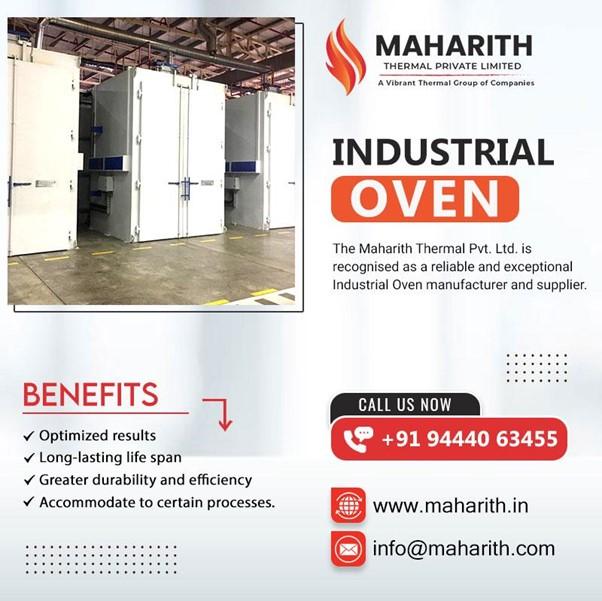Industrial ovens can be used for a variety of applications across a wide range of industries. In addition to baking, an industrial oven can be used to dry paint, apply coatings, heat treat items, cure coatings, and melt materials. While there are various sorts of industrial baking/heating/curing ovens to pick from, certain applications will benefit each organisation more than others.
Nevertheless, before purchasing an industrial/commercial oven, you should be aware of the most commonly used and popular types and applications of these ovens to make better business decisions. The last thing you need to do is to make the right choice when purchasing one. Continue reading to explore more!
The Important Factors That You Need To Consider Before Choosing An Oven
As we all know, production is very crucial in industrial settings. Choosing the appropriate oven for your application can help to increase throughput. The following are important factors to consider when selecting an industrial baking or curing oven:
Temperature control
It is critical when it comes to industrial ovens. The inability to sustain specific heating conditions might result in inferior performance or, in the worst-case scenario, complete failure of parts. Temperature controls that are often used include analog, microprocessor, and programmable proportional integral derivative controllers.
Uniformity
Temperature homogeneity is another crucial aspect to ensure that all products being tested or used in your heating process are exposed to the same constant temperature.
Airflow
Heat-up times and temperature uniformity are affected by the circulation of air in an oven. Vertical, horizontal, or a combination of both airflow patterns are possible. The texture, shape, and type of heated material all influence airflow design and implementation.
Energy Sources
Industrial or commercial ovens are often powered by electricity, hot water, microwaves, or a conveyor system, and are loaded by hand, forklift, or conveyor system.
- Electric ovens are famous for their quick heating and accurate temperature control. As a result, processing fees and production time are reduced. This oven type can be used for a variety of tasks, including baking, annealing, powder coating, and curing of paints, coatings, or finishes.
- Infrared ovens are the ideal solution for applications that require precision and speed since they maximize output while utilizing the least amount of energy. The oven immediately reaches maximum power and consistently warms surfaces mostly by electromagnetic radiation.
- Microwaves differ from other heating methods in their depth of penetration and degree of material selectivity (volumetric heating).
- Hot water or oil is frequently utilised for indirect heating.
Size
Small benchtops, reach-in, floor models, and walk-in ovens are all types of ovens. Specially built ovens are suited to specific procedures such as conveyor ovens, batch ovens, and industrial ovens for automated processes.
Control
Controls, which ensure that processes can be readily operated and inspected, are another important consideration. It is important to take into account features like a user-friendly touchscreen interface, control from a PC, smartphone, or tablet, data collection, trend graphs, maintenance alerts, and user security.
The Various Categories of Industrial Oven and Their Different Applications
Industrial baking or heating ovens are not created equal. From one type to another, they differ. You should be aware of the following common types of ovens:
Drying ovens: The Industrial Oven Manufacturers in India have created drying ovens to remove any moisture from the raw materials put within. This kind of industrialised oven operates in three stages: heating up, soaking, and cooling down. The materials are heated to the necessary temperature during the heat-up stage to remove the moisture in a predetermined amount of time. In the soaking step, materials are placed in the heat for a fixed period. Heated air is used and colder air is introduced during the cooling process.
Curing industrial ovens: These industrial/commercial ovens carry out the curing process, which is a heat treatment used to hasten the chemical reaction. With various raw materials, such as rubber, adhesives, and coatings, industrial curing ovens are employed in a variety of applications.
Continuous industrial ovens: They are the ideal option for mass-producing the same raw materials using a particular heat treatment procedure. A Continuous Oven has distinct cooling and heating chambers as compared to conventional commercial ovens.
Batch industrial ovens: Different heat processes, such as aging, drying, curing, and annealing, can be carried out in batch industrial baking ovens. The raw material batches may be loaded onto racks, trucks, or carts and then placed in the oven, depending on your production requirements.
In Conclusion
It is crucial to understand that industrial ovens are not the same as toaster ovens or standard cooking ovens. That is why, before purchasing an industrial baking/heating oven, you must first analyze your requirements. If you are confused by the numerous possibilities, it is best to get advice from commercial oven experts such as Maharith Thermal Pvt. Ltd.. They are reliable and trusted Industrial Oven Suppliers in India and can assist you in selecting the suitable and best one for your specific needs.
Frequently Asked Questions
What is an industrial oven application?
In general, these ovens heat treat a raw material by processing it at extremely high temperatures. Food production, chemical processing, and even the electronics industry are examples of typical industrial oven applications.
What is an industrial oven’s temperature?
These ovens can heat products to around 1,000 degrees Fahrenheit, with normal operational temperatures ranging between 180 and 450 degrees Fahrenheit.
What are the fundamentals of an industrial oven?
The heat sources and airflow patterns are the two primary elements of the industrial oven. Heat sources for process ovens include electric, gas, steam, water, and oil, among others. Furthermore, six basic forms of airflow must be configured with product loading.
How can an industrial oven be used safely?
- To ensure that the oven compartment has achieved the proper temperature, preheat the oven for at least five minutes.
- When working with hot materials, keep other individuals in the area in mind.
- To remove the workpiece from the oven, use thermal gloves or tongs.


